PSLV-C25 - ISRO
PSLV-C25 - ISRO
PSLV-C25 - ISRO
Create successful ePaper yourself
Turn your PDF publications into a flip-book with our unique Google optimized e-Paper software.
I<br />
N<br />
o<br />
I<br />
A<br />
· ! a i <strong>PSLV</strong> PROJECT<br />
4<br />
INDIAN SPACE RESEARCH ORGANISATION
PSlV-C22<br />
IRNSS-lA MIssion<br />
First Regional<br />
Navigation Satellite<br />
PSlV-C19<br />
RISAT-l Mission<br />
Heaviest Satellite<br />
ever launched by PSlV<br />
PSlV-C17<br />
GSAT-12 Mission<br />
Dedicated<br />
Communication Satellite<br />
PSlV-Cll<br />
CHANDRAYAAN-l<br />
Mission<br />
•• I.<br />
PSlV-C11<br />
Chandrayaan-1<br />
1380 kg<br />
255 km x 22860 km<br />
22-10-2008<br />
PSlV-C17 GSAT-12 1410 kg<br />
284 km x 21000 km 15-07-2011<br />
PSlV-C19 RISAT-1 1858 kg<br />
480 km (SSPO) 26-04-2012<br />
PSlV-C22 IRNSS-lA<br />
1426 kg 284 km x 20650 km 01-07-2013
9?SggJ-C2s/S\\.arsOrbiter ~ssio"<br />
<strong>PSLV</strong>-<strong>C25</strong>, the 25 th mission of<strong>PSLV</strong> and 5 th in the XL conRguration, will carry the Mars<br />
Orbiter Satellite (1337 kg) into a 250 km x 23500 km elliptical orbit. The Satellite will<br />
be further navigated to a hyperbolic departure trajectory and thereafter it traverses an<br />
interplanetary cruise trajectory before reaching the intended orbit around the Mars.<br />
Challenges .<br />
The major technical challenges for the Launch Vehicle in accomplishing this Mission arise<br />
from the larger Argument of Perigee (AOP) requirement ranging from 276.4 0 to 288.6 0<br />
compared to 178 0 in earlier Missions. This AOP minimises the energy required in transferring<br />
the satellite from the Earth to the Mars. In this regard, the Launch Vehicle Right regime<br />
is extended to 2657s (against 1200s for regular <strong>PSLV</strong> Missions) with a long coasting<br />
(1580-1800s) before the ignition of the PS4 stage. The long coasting necessitated specific<br />
modification and validation of the coast phase guidance algorithm, on-board battery<br />
capacity augmentation, assessment on the performance of inertial systems for extended<br />
Right duration and deployment of two Ship-borne Terminals to capture the critical telemetry<br />
data during Right in the non-visibility zone.<br />
Additional provisions are made for the thermal management of Vehicle Equipment Bay, PS4<br />
stage and also the Spacecraft elements considering the longer exposure to extreme cold<br />
space.<br />
Another unique task associated with management of this Mission is the generation and<br />
Configuration Control of multiple Initialization Filesforthe on-board computers corresponding<br />
to the different launch dates.<br />
Lift off Mass<br />
320 t<br />
Propulsion Stages<br />
First Stage<br />
Second Stage<br />
6PSOM-XL+S139<br />
PL40<br />
Third Stage<br />
HPS3<br />
Fourth Stage<br />
L2.5<br />
•<br />
Payload Fairing 3.2 m dia<br />
Mission Specifications<br />
Apogee<br />
23500 :t675 km<br />
Perigee 250 ±5 km<br />
I III<br />
••Argument of Perigee 282.55 :t 0.2 0 (For launch on 5'" November. 2013)<br />
Inclination 19.2 ± 0.20<br />
Payload Mass<br />
1337 kg
9?ofar Sateffite<br />
%uncft COefticfe<br />
The Polar Satellite Launch Vehicle (<strong>PSLV</strong>) caters to the requirements of launching<br />
satellites into Sun-Synchronous and Low Earth Orbits. <strong>PSLV</strong> is a Fourstage vehicle with<br />
alternate Solid and Liquid propulsion stages. The booster stage along with the strap-on<br />
motors and the third stage are solid motors while the second and Fourth stages use<br />
liquid engines.<br />
<strong>PSLV</strong> has the capability to launch 1750 kg class satellites into 600 km Sun-Synchronous<br />
Polar Orbit (SSPO) and 1425 kg satellites into Sub-Geosynchronous TransFer Orbit (Sub<br />
GTO) oF284 km X 21000 km. The vehicle has provision to launch multiple satellites.<br />
<strong>PSLV</strong> has successfully accomplished 2 developmental and 21 operational Missions in<br />
a row. It has established itselF as a work horse operational launcher of <strong>ISRO</strong> and has a<br />
demonstrated reliability oFO.96. Currently two variants oF<strong>PSLV</strong> are operational, namely<br />
<strong>PSLV</strong>-XL (with six extended strap-on motors attached to the First stage) and <strong>PSLV</strong>-Core<br />
Alone (without strap-on motors). <strong>PSLV</strong>-<strong>C25</strong>/Mars Orbiter Mission employs the <strong>PSLV</strong>-XL<br />
version which has already been used in Four earlier Missions.<br />
Length (rn)<br />
Diameter (rn)<br />
Propellant<br />
Solid Soild Liquid Solid Liquid<br />
(HTPB based) (HTPB based) (UH25+N z O.) (HTPB based) (MMH+MON3)<br />
<strong>PSLV</strong>-<strong>C25</strong> Vehicle<br />
Configuration<br />
Propellant Mass (t) 138 12.2 42 2.5<br />
t76<br />
Peak Thrust (kN) 4800<br />
719 799 247 7.3x2<br />
f<br />
Burn Time (s) 103 50 14B 112 525<br />
23 Successive Successful Missions Accomplished<br />
<strong>PSLV</strong> Variants Launched Successful Missions - Orbit types 63 Satellites Launched<br />
1<br />
0.96<br />
0.8<br />
0.6<br />
0.4<br />
0.2<br />
o<br />
02 03 C1 C2 cs C4 CS C6 C7 ell C10 C9 C11 C12 C14 C1S C16 C:1.7C18 C19 C21 C20 C22<br />
Rellablll1:y Achieved
••••ldofIof PS4<br />
Se_<br />
IpIltion of PSI •<br />
~ofPS3<br />
s.,...._ofPSl<br />
of PoytoadfWi ••<br />
<strong>PSLV</strong> - <strong>C25</strong> Flight Events for Launch on 5 th Nov. 2013<br />
Events<br />
Time<br />
(s)<br />
Local<br />
Altitude<br />
(km)<br />
Inertial<br />
Velocity<br />
(m/s)<br />
RCT Ignition -3.00 0.024 451.89<br />
I<br />
PSI Ignition 0.00 0.024 451.89<br />
PSOM XL 1,2 (GLl Ignition 0.46 I 0.024 451.89<br />
PSOM XL 3.4 (GL) Ignition 0.66 0.024 451.89<br />
PSOM XL 5, 6 (AL) I~nition 25.04] 2.670 611.52<br />
S.".rJdon of PSi PSOM XL 1,2 (GL) Separation 69.94 23.489 1431.80<br />
PSOM XL 3.4 (GL) Separation 70.14 23.618 1436.54<br />
PSOM XL 5,6 (AL) Separation 92.04 39.704 2024.36<br />
• PSI Separation 112.75 57.678 2387.67<br />
.......,tIonofl .•••. ·lIt<br />
PS2 Ignition<br />
-=--l12 su.pons<br />
95<br />
2387.16<br />
. t-- 57.846<br />
CLG Initiation 117.95 61.955 2415.46<br />
Payload fairing Separation 201.75 113.169 3624.69<br />
•·f 5epaqdon of. Groun6-Ut Strapons<br />
PS2 Separation 264.74 132.311 5379.33<br />
AI,,- i -<br />
PS3 Ignition 265.94 132.531 I 5378.94<br />
...'"<br />
5_<br />
PS4<br />
••••1dofI1.•••. .u.su.pons<br />
lenitionof' Gn>und-lIt<br />
~<br />
lenotlonof PSI<br />
PS3 Separation 583.60 I 194.869 7730.88<br />
Ignition 2100.50 271.317 7642.04<br />
PS4 Cut-off 2619.72 342.515 I 9833.49<br />
Mars Orbiter Separation 2656.72 383.388 9804.01<br />
I<br />
....--- Mars Orbiter Satellite --,1<br />
Payload Adaptor<br />
PS4 Stage<br />
\I'Iew from p. PSlV View from y- PSlV<br />
Payload Accommodation<br />
in <strong>PSLV</strong>-<strong>C25</strong>
0'\ars 0rbitcr<br />
Mars Orbiter Mission is <strong>ISRO</strong>'s First Interplanetary Mission with<br />
an Orbiter craft designed to orbit Mars in an elliptical orbit of<br />
366 km x 80000 km. The technological objective of the Mission is<br />
to design and realize a spacecraFt with a capability to perForm Earth<br />
Bound Manoeuvre, Martian TransFerTrajectory (MTT) and Mars Orbit<br />
Insertion (MOl) phases.<br />
Mars Orbiter<br />
Technological<br />
Objectives<br />
To develop the technologies required Fordesign, planning, management, deep space communication<br />
and operations of an Interplanetary Mission.<br />
To design and realize Mars Orbiter with a capability to survive and perForm Earth bound<br />
Manoeuvres, cruise phase oF300 days, Mars orbit insertion E captu re, and on-orbit phase around<br />
Mars.<br />
Incorporate autonomous Features to handle contingency situations.<br />
Payloads<br />
Lyman Alpha Photometer<br />
(LAP)<br />
Methane Sensor For Mars (MSM)<br />
Martian Exospheric Neutral Composition<br />
Mars Colour Camera (MCC)<br />
TIR Imaging Spectrometer<br />
(TIS)<br />
Explorer (MENCA)<br />
The scientific objectives of these payloads are exploration of<br />
Mars surFace Features, morphology, mineralogy and Martian<br />
atmosphere.<br />
Reaching Mars........ Trajectory Design<br />
The Earth-Mars transition comprises the Following three phases<br />
Earth-centered<br />
Heliocentric<br />
Martian phase<br />
phase<br />
phase<br />
Man orbit<br />
InMrdon(MOI)<br />
24-1)'1·14<br />
The SpacecraFt is injected into an elliptical parking orbit by the launcher. AFter injection of the Mars<br />
Orbiter into the orbit, Fiveorbit raising burns using Liquid Engine are planned. After these burns, the<br />
Orbiter will be given a Trans-Mars Injection (TMI) manoeuvre at perigee which will put the Spacecraft<br />
in the Mars TransFerTrajectory. AFter the end oFthe TMI, the Orbiter travels in a hyperbolic departure<br />
trajectory with which it escapes From the Earth's Sphere OF InAuence (501). AFter crossing the<br />
Earth's 501, the Spacecraft is in an elliptical interplanetary cruise trajectory around the sun For the<br />
planned transFer time after which it has its rendezvous with Mars. The spacecraFt arrives at the Mars<br />
501 in a hyperbolic trajectory. When the Orbiter reaches Periapsis, closest to Mars, it is manoeuvred<br />
For Mars Orbit Insertion (MOl), which will insert the Orbiter into an elliptical Martian orbit of<br />
366 km x 80000 km .<br />
Vemal •<br />
Equinox


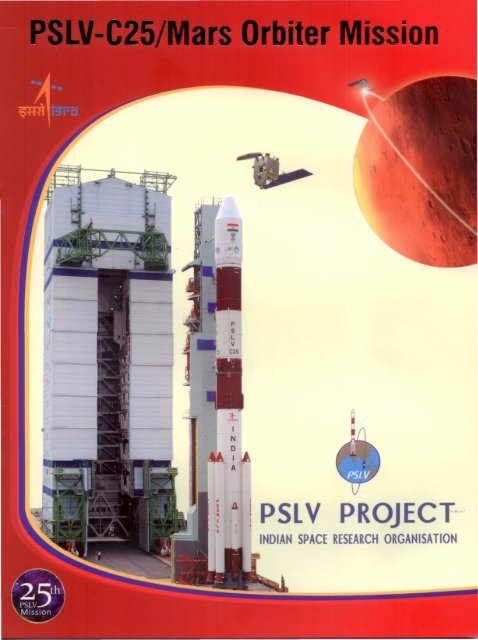
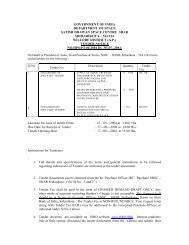
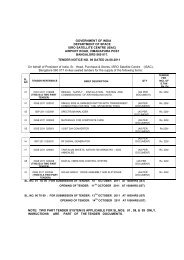

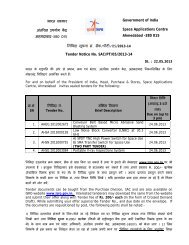
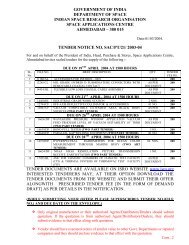
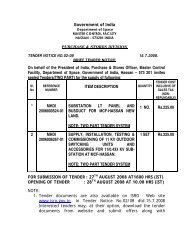
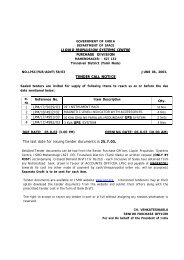

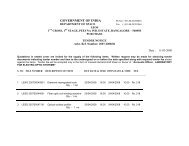
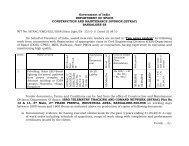
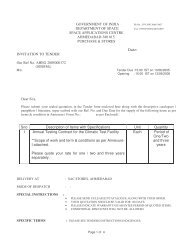

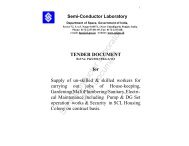
![Government of India Government of India ¢ ] ¢ ] Space ... - ISRO](https://img.yumpu.com/23555817/1/190x245/government-of-india-government-of-india-space-isro.jpg?quality=85)